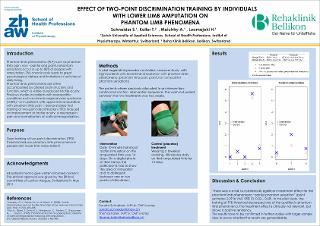Please use this identifier to cite or link to this item:
https://doi.org/10.21256/zhaw-27539| Publication type: | Conference poster |
| Type of review: | Not specified |
| Title: | The effect of two-point discrimination training by lower limb amputees on phantom limb phenomena |
| Authors: | Schneider, Sandra Koller, Thomas Meichtry, André Luomajoki, Hannu |
| et. al: | No |
| DOI: | 10.21256/zhaw-27539 |
| Conference details: | World Confederation for Physical Therapy (WCPT) Congress, Singapore, 1-4 May 2015 |
| Issue Date: | May-2015 |
| Publisher / Ed. Institution: | ZHAW Zürcher Hochschule für Angewandte Wissenschaften |
| Language: | English |
| Subjects: | Phantom limb phenomenon; Two-point discrimination; Cortical reorganization; Cortical representation; Amputation |
| Subject (DDC): | 616: Internal medicine and diseases |
| Abstract: | Background: Phantom limb phenomena (PLP) such as phantom limb pain, non – painful and painful phantom sensations occur in up to 80% of amputees. This chronic pain leads to great psychological distress and limitations in activities of daily living. Phantom limb phenomena are often accompanied by altered brain structure and function, which is visible as reduced tactile acuity. Previous studies in patients with neuropathic conditions such as chronic regional pain syndrome (CRPS) or in upper limb amputees with phantom limb pain, demonstrated that training of two-point discrimination (TPD) induced an improvement of tactile acuity, a decrease in pain and normalization of cortical reorganization. Purpose: Based on previous research in neuropathic pain conditions in upper limbs, the aim of this study was to investigate whether these results are similar in the lower limb amputees. The research question was: Does training of two-point discrimination (TPD) threshold reduce phantom limb phenomena in lower limb amputees? Methods: A pilot single-blind placebo controlled, crossover study was undertaken in a public rehabilitation clinic in Switzerland. All patients had to give written informed consent. The ethical approval was given by the Ethical committee of canton Aargau, Switzerland in May 2011. Eight lower limb amputees with phantom limb phenomena (phantom limb pain, painful or non-painful phantom sensations) where randomly allocated to an intervention-control and control-intervention sequence. The intervention consisted of a daily 10-minute training of tactile stimulation on the amputated limb over 14 days. On a digital photo of their stump, the participants had to show the area of stimulation and to distinguish between one or two points of stimulation. The control (placebo) treatment consisted of wearing a toweled stocking, 40-minutes daily on their amputated limb for 14 days. The wash-out period between the two treatments was two weeks. The primary outcome was measured as the pain intensity of the different qualities of the phantom limb phenomena (visual analog scale). Secondary outcomes were tactile acuity and patient specific-functional-scale. Statistical analysis: For each outcome, a linear mixed regression model was fitted to the data using treatment period and treatment-period interaction as covariates. This model takes into account the correlation between repeated measurements. Model assumptions were tested by residual analysis. We were interested in the treatment effect, adjusted for period and sequence. Results: There was a small, but statistically significant treatment effect for the phantom limb phenomena “painful phantom sensation” (point estimate: 0.29 in VAS, 95% CI: 0.02 – 0.69). There was no significant treatment effect for the other qualities of phantom limb phenomena’s or the second outcomes. Conclusion: In this pilot study, the training of TPD threshold decreased one of the qualities in phantom limb phenomena. The treatment effect is clinically not relevant, but shows a positive tendency. The results have to be confirmed in further studies with larger sample sizes to prove whether the results are generalizable. |
| URI: | https://digitalcollection.zhaw.ch/handle/11475/27539 |
| Fulltext version: | Published version |
| License (according to publishing contract): | Licence according to publishing contract |
| Departement: | School of Health Sciences |
| Organisational Unit: | Institute of Physiotherapy (IPT) |
| Appears in collections: | Publikationen Gesundheit |
Files in This Item:
| File | Description | Size | Format | |
|---|---|---|---|---|
| 2015_Schneider-etal_Phantom-limb-phenomena_WCPT-Poster.pdf | 373.74 kB | Adobe PDF |  View/Open |
Show full item record
Schneider, S., Koller, T., Meichtry, A., & Luomajoki, H. (2015, May). The effect of two-point discrimination training by lower limb amputees on phantom limb phenomena. World Confederation for Physical Therapy (WCPT) Congress, Singapore, 1-4 May 2015. https://doi.org/10.21256/zhaw-27539
Schneider, S. et al. (2015) ‘The effect of two-point discrimination training by lower limb amputees on phantom limb phenomena’, in World Confederation for Physical Therapy (WCPT) Congress, Singapore, 1-4 May 2015. ZHAW Zürcher Hochschule für Angewandte Wissenschaften. Available at: https://doi.org/10.21256/zhaw-27539.
S. Schneider, T. Koller, A. Meichtry, and H. Luomajoki, “The effect of two-point discrimination training by lower limb amputees on phantom limb phenomena,” in World Confederation for Physical Therapy (WCPT) Congress, Singapore, 1-4 May 2015, May 2015. doi: 10.21256/zhaw-27539.
SCHNEIDER, Sandra, Thomas KOLLER, André MEICHTRY und Hannu LUOMAJOKI, 2015. The effect of two-point discrimination training by lower limb amputees on phantom limb phenomena. In: World Confederation for Physical Therapy (WCPT) Congress, Singapore, 1-4 May 2015. Conference poster. ZHAW Zürcher Hochschule für Angewandte Wissenschaften. Mai 2015
Schneider, Sandra, Thomas Koller, André Meichtry, and Hannu Luomajoki. 2015. “The Effect of Two-Point Discrimination Training by Lower Limb Amputees on Phantom Limb Phenomena.” Conference poster. In World Confederation for Physical Therapy (WCPT) Congress, Singapore, 1-4 May 2015. ZHAW Zürcher Hochschule für Angewandte Wissenschaften. https://doi.org/10.21256/zhaw-27539.
Schneider, Sandra, et al. “The Effect of Two-Point Discrimination Training by Lower Limb Amputees on Phantom Limb Phenomena.” World Confederation for Physical Therapy (WCPT) Congress, Singapore, 1-4 May 2015, ZHAW Zürcher Hochschule für Angewandte Wissenschaften, 2015, https://doi.org/10.21256/zhaw-27539.
Items in DSpace are protected by copyright, with all rights reserved, unless otherwise indicated.